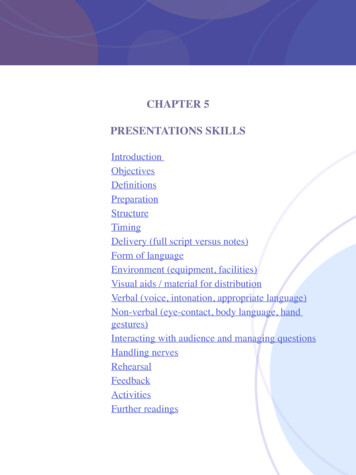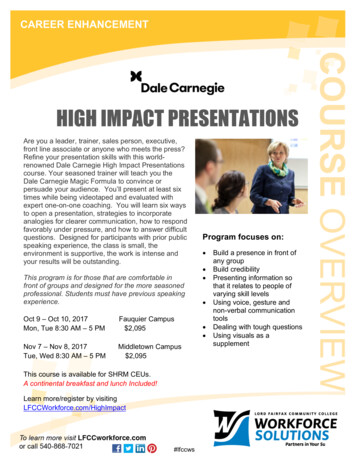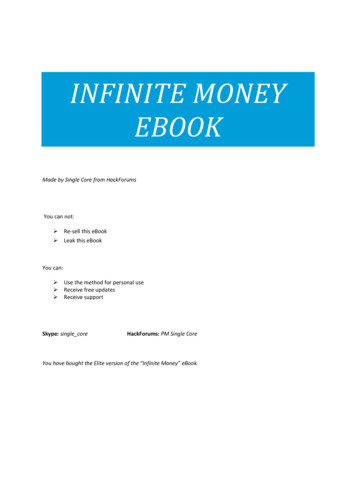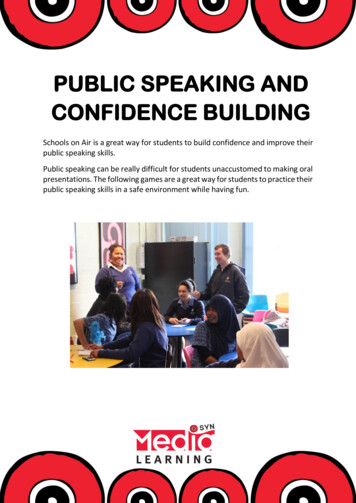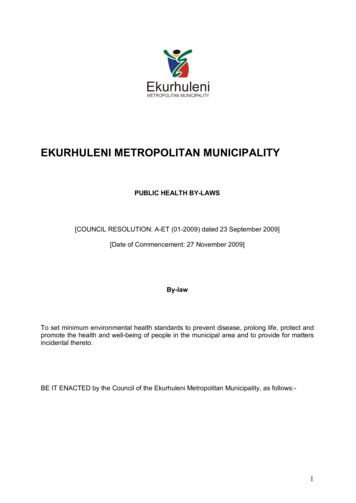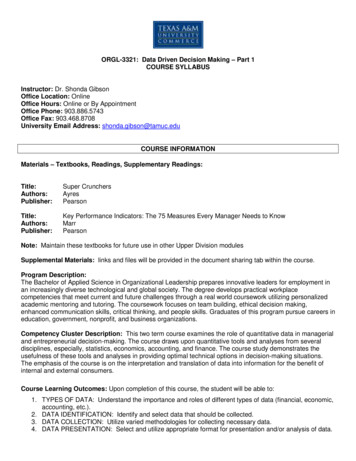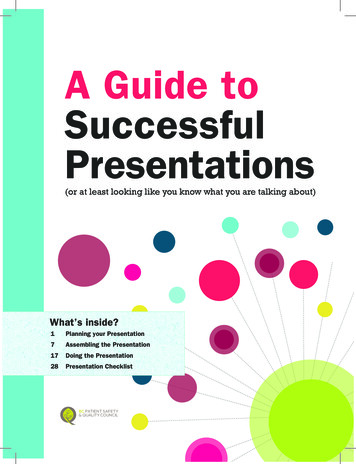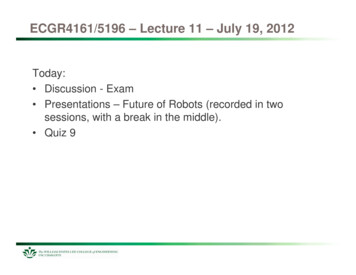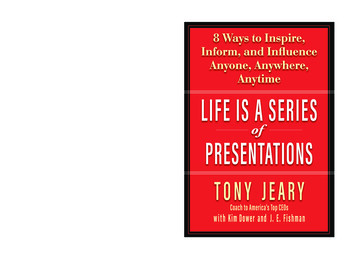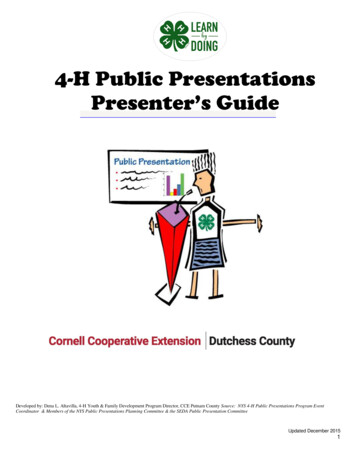
Transcription
4-H Public PresentationsPresenter’s GuideDeveloped by: Dena L. Altavilla, 4-H Youth & Family Development Program Director, CCE Putnam County Source: NYS 4-H Public Presentations Program EventCoordinator & Members of the NYS Public Presentations Planning Committee & the SEDA Public Presentation CommitteeUpdated December 20151
Youth Learn to Speak Up!4-H Public PresentationsA Guide for Youth, Parents, Evaluators & EducatorsTo some people, the thought of preparing a speech and delivering it to an audience is often considered a fate worse thandeath. However, 4-H Youth Members throughout NYS, as well as the country, have an advantage in public speaking becausethey are given the opportunity to develop and hone their speaking and communication skills through a 4-H program calledPublic Presentations.4-H Public Presentations is a nationally recognized element of the Cooperative Extension 4-H Youth Development Program.This public speaking event is one of 4-H's most beneficial and rewarding experiences. It is the program most often creditedby 4-H alumni as having given them an edge above their peers in both college and professional careers.Through a progressive series of communication activities, youth develop poise; gain self-confidence before a group; learn toexpress ideas clearly; learn how to respond spontaneously to questions; and gain subject matter knowledge.This guide will help you to better understand how the 4-H Public Presentation Program works and provide you with all thetools you need to help you plan and prepare for a successful presentation.In this guide, you will find: 4-H Public Presentations Progression Chart: This chart illustrates the different levels of evaluation that a youth participant mayadvance to. Public Presentations Types & Age-Group Expectations: An advanced guide for Parents, Evaluators and Educators, reviewing theguidelines for each presentation type/category, as well as what evaluators are looking for. The Danish System: Explains the Danish System of Evaluation Time Limits Format for Public Presentations & Introduction Guidelines: Reviews the three parts of a presentation; the Introduction, Bodyand Conclusion/Summary as well as sample introductions. Examples of Snappy or Clever Introductions Sample (Practice) Evaluation Forms: (Available Online for download)o Demonstration/Illustrated Talk Formo Recitation/Dramatic Interpretation Formo Cloverbud Demonstration (Show & Tell) / Cloverbud Pledge or Creed (Recitation) Forms Types of Public Presentations: An easy to read guide for youth presenters. (Available Online for download) Guidelines for Food Demonstrations (Available Online for download) Tips for Making Posters (Available Online for download) The 4-H Pledge/Creed: For Cloverbuds who plan to recite the 4-H Pledge/Creed (Available Online for download) Public Presentations Registration Form / Parent Volunteer Sign-up Form (Available Online for download)Updated December 20152
Dutchess County 4-H PublicPresentations 2021The skill of giving a public presentation is an invaluable life skill:4-H alumni tell us it is the single most valuable thing they learned in the program.Employers say it is one of the most useful and essential skills to their workforce.Successful completion of a Public Presentation is a requirement to complete your 4-H year in good standing andtake part as a 4-H'er in the Dutchess County Fair.Please reach out to a 4-H staff member if youth need special accommodations. Our gaol is to build confidenceand competence by making this a great learning experience - we are here to help.There will be several options to complete your public presentations in 2020-21; Fall Food Festival - if you completed this in November 2020 you are good! Spring Food Festival - April 2021 - see separate instructions In-person public presentations scheduled at the CCEDC Farm and Home Center - see email and website Virtual Public Presentations via a live connection with a designated evaluator - see email and website Horse Communications - on horse-specific topics but open to any 4-H'er - contact 4-H staff.CHECK YOUR EMAILSGO TO THE 4-H WEBSITE FOR DETAILSBE SURE TO SIGN UP ON TIMEPLEASE NOTE:COVID-19 heavily impacts how many presenters we can accommodate in person and the procedures followedat each event. Be sure to be punctual, well-preppared and willing to follow all protocols as detailed in emailsand on the 4-H website.Help us to help you stay safe!Updated December 20153
4-H Public Presentation Progression Chart4-H Public Presentations is a progressive program that allows youth participants the opportunity to advance tomore challenging levels of evaluation through a coordinated series of events, each taking place in a differentsetting. Each time a presenter is evaluated, they then have an opportunity to fine-tune their presentationbefore taking it to the next level. The higher a participant advances, the more competitive the programbecomes. It is through the evaluation process that 4-H members experience mastery, gain valuable skills inlistening to the recommendations of others, and continue to develop confidence in themselves.LEVEL 1: 4-H Club Training and Practice4-H Members begin their public speaking training at theclub/classroom level by selecting a topic of interest, preparing apresentation and then delivering it to their peers during a 4-H ClubMeeting.LEVEL 2: 4-H County Public PresentationsAll 4-H’ers (5-19 years old) are then invited to give their presentation to a community audience at acounty-wide event in front of trained volunteer Evaluators. The Evaluators constructively critiqueeach presentation, using the Danish System (see The Danish System on page 8) as the primarymethod of evaluation, and provide positive feedback as well as suggestions for improvement.LEVEL 3: 4-H District Public PresentationsThose youth (ages 9 & up) who demonstrate a readiness for a more challenging presentation, may be given anopportunity to advance to the next level – District (Regional) 4-H Public Presentations. At this level, using the same– but more polished – presentation, presenters speak to a moving audience in a public venue, once again beingcritiqued by trained Evaluators. (Some counties may also invite 4-H Members to give their Public Presentation atthe NYS Fair and/or a County Fair. Please be sure to check with your 4-H Educator). Please Note: Advancing to DistrictPresentations is a progressive process and therefore is evaluated on a higher standard than at the County Level.LEVEL 4: NYS 4-H Public Presentations Event (If Offered)4-H teens (ages 13 & up) who have demonstrated exceptional public presentation skills may be selected to advanceand give their presentation at the NYS 4-H Public Presentations Event.Please Note: Advancing to NYS Presentations is a progressive process and therefore is evaluated on even a higher standardthan at the District Level.Updated December 20154
4-H Public Presentations Types & Age-group Expectations A Guide for Parents, Club Leaders & Evaluators To use this chart: please find the age of your child or children in your club. Reading across please note the types of presentationcategories that a youth may select from as well as the expectations of the Evaluators will have.Presentation Length /Opportunity toAdvancePresentation Types tochoose from for age levelExpectations for age &experience levelCloverbuds, Ages 5 & 6Presentation Types / CategoriesExpectationsPresentation Length: 1 to 5minutes* Recitation: A recitation of the 4-H Pledgeor Creed.This is a lead-up activity that “readies ”the young Cloverbud for participationin the Public Presentation program. Aspecial Cloverbud Comment Sheet isused (no ratings or scores are given)and a dialogue between the cloverbudand an adult Evaluator takes place,providing motivation and praise.Emphasis is on self-expression andhelping the member feel comfortablespeaking to a small group of peers andadults.* Show & Tell (Demonstration): A simpleshow & tell to help relieve jitters.Advancement: Cloverbudpresentations provide anopportunity for young children tobegin to feel comfortable speakingin front of an audience.Competition is not appropriate forchildren of this age; thereforeCloverbuds cannot advance toDistrict or State levelpresentations.Introductions: At this age level, thestandard Introduction of “Hello myname is ” may be used. (For moreinformation see the Introduction Guidelines onpage 9-12)Cloverbuds, Age 7Presentation Types / CategoriesExpectationsPresentation Length: 3 to 8minutes* Demonstration: The presenter shows howto do, make or prepare something one stepat a time. Models or illustrations may beused as needed to explain information, showthe steps in the process being demonstratedor show a larger scale replica of somethingthat is too small for the audience to see.Cloverbuds who have already had apositive Show & Tell experience and/orfeel confident about trying aDemonstration may do so. Althoughthe three parts of a presentation(Introduction, Body & Conclusion) arelearned at this level, the focus is still onhelping the member to feelcomfortable. Cloverbuds are notexpected to do a polished job. A specialCloverbud Comment Sheet is used; noratings or scores are given. Theevaluator encourages and coaches in ahighly positive manner. Introductions:At this age level, first time presentersmay still use the standard Introductionof “Hello my name is ”. Howeverpresenters with one or two yearsexperience should begin to incorporatea clever introduction that will grab theaudience’s attention. (For moreAdvancement: Cloverbudpresentations provide anopportunity for young children tobegin to feel comfortable speakingin front of an audience.Competition is not recommendedfor children this age, thereforeCloverbuds cannot advance toDistrict or State levelpresentations.Some examples include: how to jugglehow to make peanut butter & jellyhow to do a magic trickhow to care for a pethow to set the tablesupplies you need to go fishinginformation see the Introduction Guidelines onpage 9-12)Updated December 20155
4-H Members, Ages 9-11Presentation Types / CategoriesExpectationsPresentation Length: 5 to 12minutes (Time may vary depending on* Demonstration: The presenter shows andexplains how to do or make something (howto juggle, do basic dance steps, build a kite,make cookies, care for a pet, etc.). Modelsor illustrations are used as needed to explaininformation; show the steps in the processbeing demonstrated; show a larger scalereplica of something that is too small for theaudience to see; or reveal a finishedproduct. Team demonstrations are allowedif the presentation requires two people forefficient use of time and effectivenessrelative to the presentationEmphasis is now shifted to theDemonstration format and some of thefiner points of organization. Themember is expected to both show howand explain why. The member shouldknow enough background informationto answer reasonable questions fromthe Evaluators and/or the audience.Members who have done a successfulDemonstration, are encouraged to tryan Illustrated Talk.age & experience. Time limits are strictlyenforced at the District Level).Advancement: 4-H Members whodemonstrate a readiness for amore challenging opportunity, maybe selected to give theirpresentation at the next level District (regional)4-H Public Presentations. At thisevent, presenters speak to amoving audience at a public venue,once again being critiqued bytrained Evaluators.* Illustrated Talk: The presenter uses visualaids to tell about the topic. The effective useof charts, pictures, posters, slides,overheads, graphs, examples, models, etc.play a major role in communicating thepresenter's message. Team illustrated talksare NOT permitted.At this level, trained Evaluatorsconstructively critique eachpresentation, using the Danish Systemas the primary method of evaluation.Upon conclusion of the presentation,the Evaluator’s consult with eachindividual presenter to provide positivefeedback as well as suggestions forimprovement. NEW: REMEMBER toCite at least 2 different sources tovalidate your topic research.Introductions: At this age andexperience level, the presenter maystill include some basic informationabout him/herself but the introductionshould now begin to show morecreativity and an understanding of howto engage the audience’s attention.(For more information see the IntroductionGuidelines on page 9-12)4-H Members, Ages 12-14Presentation Types / CategoriesExpectationsPresentation Length: 10 to 15minutes (Time limits are strictly enforced* Demonstration: See aboveat the District & State Level)* Illustrated Talk: See above.Creative Communications: Bridges the gapbetween message-delivery and theperforming arts. Art forms such as recitation,dramatic interpretation, puppetry, skits,clowning, singing, music, and story tellingare used as the vehicle for conveying amessage.At this level, format, showmanship, andpresentation technique areemphasized equally. Presentations areexpected to be informative, wellorganized and presented in aninteresting manner. Members whohave already successfully completed aDemonstration or Illustrated Talk arenow encouraged to try a CreativeCommunication (Recitation orDramatic interpretation) presentation.* Dramatic Interpretation: The presenter orteam delivers a re-enactment of a piece ofscripted material. Content of theTrained Evaluators constructivelycritique each presentation, using theDanish System as the primary methodAdvancement: 4-H Members, whodemonstrate a readiness for amore challenging opportunity, maybe selected to advance to District(regional) 4-H Public Presentations.At this event, presenters speak to amoving audience at a mall, onceagain being critiqued by trainedEvaluators.Updated December 2015Continued on next page6
4-H Members, Ages 12-14Continued 4-H Members, 13 years and older,who demonstrate exceptionalpresentation skills at the Districtlevel, may be selected to advanceto NYS 4-H Public Presentations atCornell University.presentation can be taken from plays,movies, sketches, and monologues-dramatic or comedic. This form ofpresentation, by definition, should includeprops and costumes. Props need to besimple and minimal, not detracting from thestrength of the presenter(s).* Original pieces written by the presenter(s)are accepted in this category. Teamdemonstrations are permitted. (4-Heducators should monitor Appropriatenessof the presentation).* Recitation: The presenter, with the use ofvocal inflection and body language, delivershis/her rendition of a piece of pre-writtenmaterial. Props may not be used, butappropriate dress to subtly represent thecharacter or mood of the written piece isacceptable. Dress should not overwhelmthe presentation. Memorization isexpected, but notes are permitted. Thisarea is not intended for presentation oforiginal pieces written by the presenter.Teams are not permitted.of evaluation. Upon conclusion of thepresentation, the Evaluator’s consultwith each individual presenter toprovide positive feedback as well assuggestions for improvement. NEW:REMEMBER to cite at least 3 differentsources to validate your topicresearch.Introductions for Demonstrations &Illustrated Talks: An Introduction atthis level of experience should begin tobe an intricate piece of thepresentation. It should stimulate theaudience’s interest and curiosity, andprovide a “window” into thepresentation without giving all of thepieces of the presentation.Introductions for CreativeCommunication Presentations:(Recitations and/or DramaticInterpretations) should include someinteresting information about theauthor of the piece being presentedand information about why thepresenter might have chosen thispiece. “Setting the stage” is animportant piece of this Introduction.(For more information see the IntroductionGuidelines on page 9-12)4-H Members, Ages 15-19Presentation TypesComments and ExpectationsPresentation Length: 10 to 15minutes (Time limits are strictly enforced* Demonstration: See aboveat the District & State Level)* Illustrated Talk: See aboveAdvancement: 4-H Members whodemonstrate a readiness for amore challenging opportunity, maybe selected to give theirpresentation at District (regional)4-H Public Presentations. At thisevent, presenters speak to amoving audience at a public venue,once again being critiqued bytrained Evaluators.Creative Communications: See aboveAt this age and experience level, teensshould be able to deliver a polishedand professional Demonstration and/orIllustrated Talk. They are encouragedto try one of the other presentationtypes if they have not already done so.Presentations should emphasizedelivery and showmanship sinceformat and organization should besecond nature by now. The FormalSpeech is an appropriate challengebecause the speaker has nothing buthis/her own voice and body to retainaudience attention and communicatethe message. Trained Evaluatorsconstructively critique each* Dramatic Interpretation* Recitation*Formal Speech: Call 4-H Office for SpeechGuidelines. Must have completed at least 2prior Demonstrations or Illustrated Talks atDistrict Level.Updated December 20157Continued on next page
4-H Members, Ages 15-19Continued * Teen Interviews: Mock College or JobInterview – Call 4-H Office for guidelines.4-H Members, who demonstrateexceptional presentation skills atthe District level, may be selectedto advance to the highest level ofcompetition – NYS 4-H PublicPresentations (if offered).presentation, using the Danish Systemas the primary method of evaluation.Upon conclusion of the presentation,the Evaluator’s consult with eachNEW: REMEMBER to cite at least 3different sources to validate yourtopic research.Individual presenter to provide positivefeedback as well as suggestions forimprovement.Introductions: An Introduction at thislevel of experience should begin to bean intricate piece of the presentation.It should stimulate the audience’sinterest and curiosity, and provide a“window” into the presentationwithout giving all of the pieces of thepresentation.NOTE reference technology: CCEDC do not guarantee that the available technology equipment will be compatible withyouth devices. It is recommended that youth bring a flash drive as a backup and speak to 4-H staff well in advance.Team Presentations: Team presentations consist of no more than two presenters. Both presenters are scored individually and theirscores are averaged together for an overall total.Other Public Presentation Categories: Teen (Mock Job or College) Interviews, Speech, Impromptu Speaking and/or Horse Communications Categories mayalso be available; contact your local 4-H Educator for additional information.IMPORTANT GUIDELINES: Cite your research sources: 4-H Presenters will now be expected to cite the sources they used for any researchdone on their topic to prepare for their presentation. This can be done by listing the sources on a paper or posterand hanging it up for the Evaluators to see; incorporating your sources into your actual presentation; or bring theactual sources (books, maps, magazines, etc) with you to share during or after presentation. Tell us what you are wearing: If the clothing you are wearing is meant to enhance or compliment yourpresentation, be sure to incorporate that into your presentation. In many cases, it may be obvious, such as if yourare doing a cooking demonstration and wear a chef’s hat; however there may be occasions where the Evaluators &Audience might not be aware of the fact that your clothing related to your topic, for example, if you are doing apresentation about skate boarding and chose to wear ripped jean shorts. In general, all presenters are expected todress neat and clean; a costume or special clothing is not required but may help to enhance your presentation.The Danish System:Cornell Cooperative Extension’s 4-H Youth Development program uses the Danish Judging System as its primarymethod for evaluating 4-H Public Presentations. Using this method, each youth presentation is evaluated basedon the “ideal” standard for the presenters’ age, experience, ability and developmental level. Therefore, eachpresentation is not compared to or in competition with other presentations.Updated December 20158
Guidelines for Time Limits:When it appears as if a presenter may go over his/her allotted time, either the Evaluator or Room Host will holdup a warning card (see sample below), to let the presenter know they are almost out of time.Yellow Card @ 12 min (“3-min warning”): Indicates that the Summary or conclusionshould Begin now.Red Card @ 15 min (“Exceeds Time Limit”): Indicates that the Summary orConclusion should be done. Time for presenter to ask audience for questions.Please Note: The question and answer period at the end does not count towards your presentation time. Furthermore,presenters’ should be aware that penalties for exceeding time limits are imposed at the District and State Levels.Format for Public Presentations & Introduction Guidelines Guidelines for Introductions & Summaries /Conclusions All types of 4-H Public Presentations (with the exception of Teen Interviews, Speech, Cloverbud Pledge / MottoRecitation and Show & Tell) share the same three-part format: an introduction, body, and conclusion or summary.The content and presentation techniques used in each part vary somewhat depending on the type ofpresentation. Introductions: In the past, 4-H Members have been taught to begin their presentation with thestandard “Hello, My Name is and I am years old and am a member of 4-H Club”.We live in a fast paced world! To be successful in the 21st Century, you’ve got to grabpeoples’ attention in 30 seconds or less.Since all of the factual information is already printed on the top of the Evaluation Form, 4-Her’s are nowrequired to make the most out of their introductions. A flashy introduction and title, which incorporatesat least the presenter’s first name, should catch, arouse or draw the audience’s interest within the first 15seconds.o Cloverbud Presenters may use the standard Introduction of “Hello my name is ”. Afterthey become more experienced, they may begin incorporating snappy or clever introductions. Sample Cloverbud Intro: “My name is , I am years old”. “The Titleof my presentation is How to Make a Peanut Butter and Jelly Sandwich”or “Today I am going to show you how to make a peanut butter and jelly sandwich”.o For Demonstrations & Illustrated Talks, the presenter will begin by introducing his/her topic in amanner that creatively catches the attention of the audience while either stimulating their curiosityor providing information about the subject; the presenter’s first name may be incorporated in tothe creative introduction. Sample (Demonstration) Intro: (A football is thrown from the side of the room andcaught by the presenter who is dressed in football uniform). “If you have ever watched a football game, youknow how important it is for the players to be able to throw and catch the ball skillfully and today, I, Joe Smith,will show you how.”Updated December 20159
Sample (Illustrated Talk) Intro: “Vehicular accidents are the number one killer of youth ages 16 to 20 MyName is Sam and today I will share these statistics with you”.o For Creative Communication categories, the presenter should identify the source of the creativepiece and it's author and may allude to, explain or challenge the audience to discover the messageit conveys prior to beginning. The setting as well as the presenter's reason for choosing thisparticular piece may also be included at this point if so desired. Once again the presenter’s firstname should be incorporated into the creative introduction.More Examples of Snappy & Clever Introductions . A Short, Snappy Sentence:o “Help! I’ve just lost my steering! Not my car, but on how to groom that beautiful steer out in thebarn.”o (Yell) “Fire in the kitchen! Please don’t leave an empty pizza box in the oven.” Quote:o “To bee or not to bee, that is the question.” According to Shakespeare (if doing a presentationabout Bees)o "Snowflakes are one of nature's most fragile things, but just look what they can do when they sticktogether." - Vista M. Kelly new what she was talking about when she reminds us how small thingsworking together can make a difference Question:o “Would you rather be going the right way or the wrong way? I would rather be steering in the rightdirection.”o “Did you know that manure could be very useful? Manure makes excellent compost for yourgarden. Hi my name is , and I am going to tell you how to set up a home composting system torecycle the manure from your farm animals.” Surprising Fact:o “Vehicular accidents are the number one killer of youth ages 16 to 20”o “Both insects and fish use a form of ‘anti-freeze’ that keeps them alive – even after being frozen.” Joke or Funny Story (Be careful not to offend your audience and make sure it relates to the topic):o “Doctors are one of the most educated and trained professions and yet everything they do is calledtheir practice.”o “Why do we park on the driveway and drive on the parkway?” Relate a Personal Experience:o “While on vacation last summer I was able to save a life by using CPR.”o “Traveling to another country was an amazing experience for me ” Show an Unusual Object:o “I found this snake skin last year while hiking in the Adirondacks .”o “This fossil is hundreds of thousands of years old.”Updated December 201510
Describe Dramatic/Historical Significance:o Martin Luther King’s inspirational words, in his ‘I have a dream’ speech, marked an unprecedentedturning point in our nation’s history. Body Conclusion or Summary (The presenter emphasizes or re-emphasizes the message of the(This is the main part of the presentation):o In a demonstration a technique or steps of a process are shown.o In an illustrated talk or speech, the main points are identified and explained.o In a creative communication presentation the creative piece is performed.presentation):o In a demonstration or an illustrated talk the most important steps or points are summarized.o In a creative communication presentation, the conclusion depends on the type of creative pieceand how it was introduced. A conclusion may be built into the piece itself or the message may beemphasized through a simple comment, a brief analysis, an expressive body movement (loweringone's head) or even through dialog with the audience.Please note that this part of the presentation is called a summary in a demonstration or an illustrated talkbecause it calls for a summary of the material presented; and called a conclusion in a speech, recitation ordramatic interpretation due to the fact that it requires the presenter to bring his talk to a conclusion.Definition of Final Ratings on 4-H Presentation Evaluation Forms WORTHY (WHITE): This rating is determined if the overall level of accomplishment generally needsimprovement GOOD (RED): This rating is determined if the overall level of accomplishment generally meets expectationsand is of a competent level in most areas. EXCELLENT (BLUE): This rating is determined if the overall level of accomplishment is generally aboveaverage.OUTSTANDING (PURPLE): This rating is determined if the overall level of accomplishment is outstanding, wellabove average in the majority of areas and of 'star' quality.Updated December 201511
4-H Public Presentations is a nationally recognized element of the Cooperative Extension 4-H Youth Development Program. This public speaking event is one of 4-H's most beneficial and rewarding experiences. It is the program most often credited by 4-H alumni as having given them an edge ab
